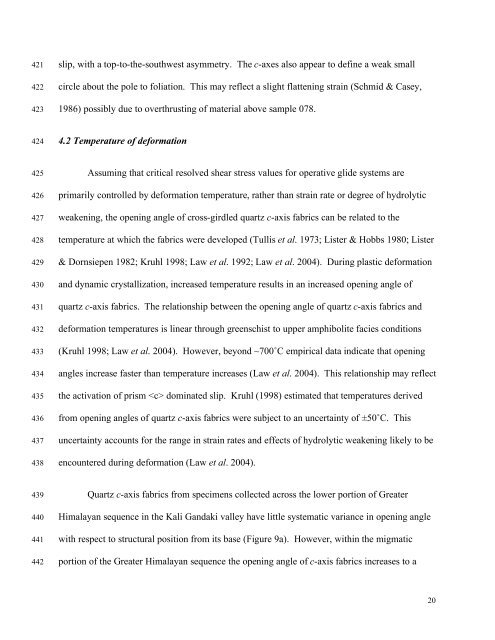Kinematics of the Greater Himalayan sequence, Dhaulagiri Himal ...
Kinematics of the Greater Himalayan sequence, Dhaulagiri Himal ...
Kinematics of the Greater Himalayan sequence, Dhaulagiri Himal ...
You also want an ePaper? Increase the reach of your titles
YUMPU automatically turns print PDFs into web optimized ePapers that Google loves.
421<br />
422<br />
423<br />
slip, with a top-to-<strong>the</strong>-southwest asymmetry. The c-axes also appear to define a weak small<br />
circle about <strong>the</strong> pole to foliation. This may reflect a slight flattening strain (Schmid & Casey,<br />
1986) possibly due to overthrusting <strong>of</strong> material above sample 078.<br />
424<br />
4.2 Temperature <strong>of</strong> deformation<br />
425<br />
426<br />
427<br />
428<br />
429<br />
430<br />
431<br />
432<br />
433<br />
434<br />
435<br />
436<br />
437<br />
438<br />
Assuming that critical resolved shear stress values for operative glide systems are<br />
primarily controlled by deformation temperature, ra<strong>the</strong>r than strain rate or degree <strong>of</strong> hydrolytic<br />
weakening, <strong>the</strong> opening angle <strong>of</strong> cross-girdled quartz c-axis fabrics can be related to <strong>the</strong><br />
temperature at which <strong>the</strong> fabrics were developed (Tullis et al. 1973; Lister & Hobbs 1980; Lister<br />
& Dornsiepen 1982; Kruhl 1998; Law et al. 1992; Law et al. 2004). During plastic deformation<br />
and dynamic crystallization, increased temperature results in an increased opening angle <strong>of</strong><br />
quartz c-axis fabrics. The relationship between <strong>the</strong> opening angle <strong>of</strong> quartz c-axis fabrics and<br />
deformation temperatures is linear through greenschist to upper amphibolite facies conditions<br />
(Kruhl 1998; Law et al. 2004). However, beyond ~700˚C empirical data indicate that opening<br />
angles increase faster than temperature increases (Law et al. 2004). This relationship may reflect<br />
<strong>the</strong> activation <strong>of</strong> prism dominated slip. Kruhl (1998) estimated that temperatures derived<br />
from opening angles <strong>of</strong> quartz c-axis fabrics were subject to an uncertainty <strong>of</strong> ±50˚C. This<br />
uncertainty accounts for <strong>the</strong> range in strain rates and effects <strong>of</strong> hydrolytic weakening likely to be<br />
encountered during deformation (Law et al. 2004).<br />
439<br />
440<br />
441<br />
442<br />
Quartz c-axis fabrics from specimens collected across <strong>the</strong> lower portion <strong>of</strong> <strong>Greater</strong><br />
<strong><strong>Himal</strong>ayan</strong> <strong>sequence</strong> in <strong>the</strong> Kali Gandaki valley have little systematic variance in opening angle<br />
with respect to structural position from its base (Figure 9a). However, within <strong>the</strong> migmatic<br />
portion <strong>of</strong> <strong>the</strong> <strong>Greater</strong> <strong><strong>Himal</strong>ayan</strong> <strong>sequence</strong> <strong>the</strong> opening angle <strong>of</strong> c-axis fabrics increases to a<br />
20

















